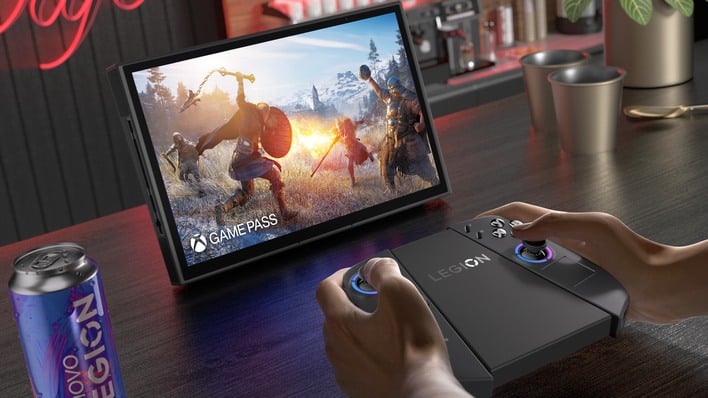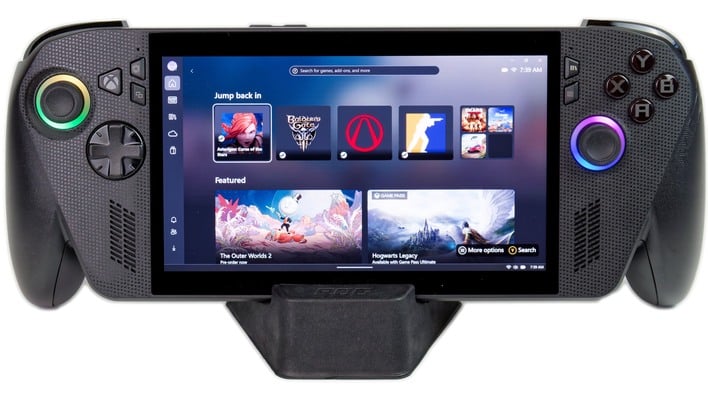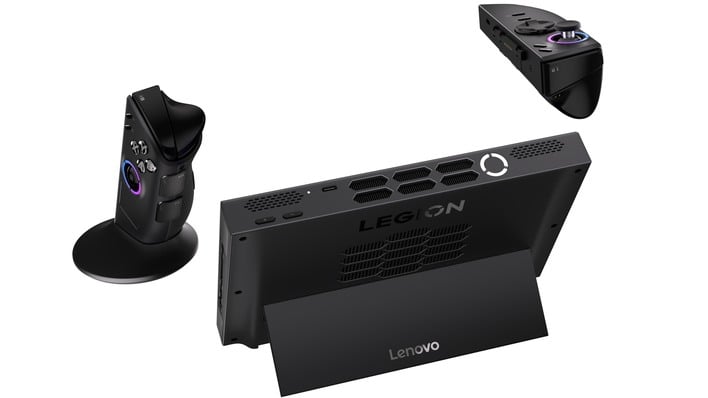ROG Xbox Ally X Vs Lenovo Legion Go 2: Which Handheld Gaming Device Wins 2025?
So if you're in the market for a high-end gaming handheld, which one should you pick? In the strictest sense, neither of these devices are halo-tier machines; the extant systems based on Strix Halo (heh) processors, like the GPD Win 5 and Ayaneo Next II, absolutely brutalize these systems in terms of raw performance. They're also significantly more expensive, with the absolute cheapest GPD Win 5 model going for $1,599 at retail, so we're not going to include those devices in this comparison today.
Instead, this is a head-to-head, a direct comparison, between ASUS' finest handheld machine and Lenovo's greatest Go system: The ASUS ROG Xbox Ally X and the Lenovo Legion Go 2. Handheld machines are a lot more than just the specifications, but let's take a look at the specs anyway, because they're informative:

There's quite a bit to compare just from the specifications. The two machines offer fundamentally the same SoC, although the version of the Ryzen Z2 Extreme in the ROG Xbox Ally X retains its AI-accelerating NPU—for what that's worth. Otherwise, they're the same chip, with three Zen 5 cores and five Zen 5c cores, running at 2GHz base and clocking up to 5GHz boost. Sixteen threads, 16MB of last-level cache, you know the drill.
Both machines also boast the same powerful integrated GPU with eight RDNA 3.5 Workgroup Processors, giving them fully sixteen compute units. This is the full-fat GPU for the Strix Point die on which these processors are based, and it's quite potent when it isn't being held back by power limits or memory bandwidth—which is rarely not the case.
Not that these machines have slow RAM. Both systems sport 128-bit memory buses with LPDDR5X memory running at 8Gbps. That provides 128GB/second of memory bandwidth, exactly the same as a Radeon RX 6400 desktop GPU, or as much as a Radeon HD 7850 from back in the day. Of course, it's shared with the CPU cores, so the GPU does get a proportionally lower figure to fight with. This memory bandwidth limitation does restrict performance, but as long as you keep the game resolution low, it's not a huge problem. Ultimately the SoC's strict 35W (ASUS) or 40W (Lenovo) power limit will be the final bottleneck for performance.
However, they do differ in the amount of RAM; the ROG Xbox Ally X brings forward the original Ally X's 24GB of RAM, while the Legion Go Gen 2 that we're looking at comes with 32GB. Make no mistake; 16GB is not enough RAM for this class of SoC. Why? Because the memory has to be shared between the CPU and GPU. The 24GB of the ROG Xbox Ally X gives it enough for 16GB of system RAM while dedicating 8GB to the GPU; this is just enough for modern games at low resolutions. The 32GB of the Legion Go 2 is better, though, as it gives more headroom for the future. A clear win for Lenovo.
Arguably the single biggest difference in these handhelds has to do with their screen selections. The ROG Xbox Ally X uses a perfectly acceptable 7-inch IPS LCD in 1920×1080 that refreshes at 120Hz and supports Freesync. This is the exact same screen that was used in the original ROG Ally, and at that time it was exceptional among gaming handheld displays. That was two and a half years ago, though, and things have moved on since then.
The Legion Go Gen 2's display is a massive 8.8-inch OLED in 1920×1200 resolution that refreshes at 144Hz, supports Freesync, is rated for 97% of the DCI-P3 colorspace, and VESA DisplayHDR TrueBlack 1000 certified. This is both good and bad: it's good, because the screen is absolutely gorgeous; it makes the really quite nice display on the ROG Xbox Ally X look washed-out by comparison. It's bad because it's gigantic, and it makes the machine quite large. The 16:10 resolution is also still a bit awkward in some games that don't properly support it.
Don't get us wrong—the screen is absolutely acceptable on the ASUS ROG Xbox Ally X. If you've played on an Ally or Ally X before, you already know what to expect; it's razor-sharp and plenty bright. However, the Legion Go Gen 2's display is in an entire other class of computer screen. It doesn't really even bear comparison. Of course, it does have the usual OLED downsides of limited lifespan and potential for image retention, but hopefully nobody's leaving their handhelds on displaying an image for ten hours a day, every single day.
As we noted, the Legion Go 2's large screen makes it a considerably more massive device, and that's borne out in the specs—the Legion Go Gen 2 is fully 33% heavier than the ASUS ROG Xbox Ally X. That's not just down to the extra size; the mechanisms to support the detachable controls (and the batteries for the controls) also add to that weight. By all accounts, the Legion Go Gen 2 is heavy enough to be unwieldy for longer play sessions, but the counterpoint to that is that it has a kickstand and detachable controls, so you can simply set it on the table and play that way. But then, if you're going to do that, what's the point of a handheld?
While we haven't tested the battery life on the Legion Go Gen 2, we expect that the ROG Xbox Ally X will easily win the day there. The reason is because of the smaller, dimmer screen, the reduced amount of memory, and the slightly larger battery. We were able to pull out gameplay times from the ASUS ROG Xbox Ally X that are frankly irresponsible, so unless you're trying to play something like Cyberpunk 2077 at 60 FPS—fully possible, by the way—you won't have battery life troubles on the ROG Xbox Ally X.
Lenovo does pick up another clear win in the storage category, though. Simply speaking, it has 2TB of storage, and from the data that we've seen, Lenovo is shipping speedier SSDs than ASUS is, too. Both machines can accept M.2-2280 SSDs, so it's actually relatively easy to replace the internal storage with whatever SSD you want, and there's the argument to be made that 1TB is actually plenty for this kind of device, but more is always better.
Neither device has satisfying storage expansion. UHS-II MicroSD cards are expensive and can be hard to come by; they also offer disappointing speed compared to the internal SSD. We would like to see a move toward SD Express on these handheld devices; Nintendo already made the jump, so it's crazy that these high-end handhelds haven't done so. There's also that interesting Mini SSD device from Biwin, but it appears to be proprietary and we wouldn't want to proliferate a proprietary standard. Still, it's even faster than SD Express.
As far as the unique features of each machine go, well, on the ASUS ROG Xbox Ally X, there's the new Xbox Full Screen Experience. That's actually available on any Windows system now, but only the ASUS machine has the dedicated Xbox Guide button to invoke it. The ROG Xbox Ally X also has large shaped handgrips that I'm particularly fond of, but others with larger hands say the machine is radically more comfortable. The screen on the ASUS ROG Xbox Ally X is slightly tilted upward from the handgrips, and that can give a more comfortable viewing position when playing while seated, although it's not great for some other positions.
The Legion Go 2 has the more interesting unique features by far. We already talked about the amazing HDR OLED screen, but it bears repeating; you need to see this thing in person. There's also the unique nature of the Legion Go 2 that it carries forward from the original Legion Go, though. That's the fact that it can be used more or less like a tablet, with the controls detached. You can use the controls apart, and the right one has an optical sensor on the bottom that allows it to be used as a mouse. You can also snap the controls into a "grip" that turns them into something like a wireless gamepad. There are even third-party grips that have a battery.
The Legion Go 2's "TrueStrike" controllers also have a touchpad on the right-hand side. Unlike the minuscule one on the Legion Go S (where we would have preferred that it simply wasn't included), this one is more similar to the size of the touchpads on the Steam Deck and looks considerably more usable. Lastly, we must point out that the analog inputs on the Legion Go 2's included controllers use magnetic Hall-effect sensors. The analogs on the ASUS device are not Hall-effect, which means they could wear over time, although they are modular and easily replaceable, with many aftermarket kits available.
Finally we come to the elephant in the room, which is the pricing. There's no getting around it: these machines start at about a thousand dollars. That's a lot to pay for a system that plays PC games on integrated graphics. On the other hand, if you haven't owned one of these devices, the convenience is hard to overstate; just snatch your system off the charger, wake it up from sleep, and get right back to playing whatever game you were playing before, wherever you are, without having to sit in a specific spot at a certain machine. Particularly for those who travel a lot, or share a space with others, these PC gaming handhelds are extremely attractive.
Lenovo Legion Go 2 Gaming Handheld: $1,349 at Best Buy
Comparing strictly these two devices, it's clear that the Legion Go Gen 2 is the better machine. It has more memory, it has a much better screen, it has double the storage out of the box, and it has the better unique features. It's also an extra $350 over the already-expensive ASUS ROG Xbox Ally X, though. If you are considering one of these handhelds, an extra 35% on the price could be enough to swing you either way. They're both going to play the same games with minimal performance differences between them, after all.
Lenovo Legion Go S Z2 Go 16GB: $649 at Best Buy
Original Lenovo Legion Go Z1E 16GB: $699 at Best Buy
Still, it has to be said that once we get into the range of $1,349 USD, it becomes awfully tempting to stretch an extra $250 for the entry-level model of the GPD Win 5. That machine retails for $1,599, and while it's a downgrade from the Legion Go Gen 2 in many areas—being overall more comparable to the ROG Xbox Ally X in terms of the screen, the controls, and the form factor—it is a radical upgrade in performance, with double or more the realized frame rate in most games. If you're a serious enthusiast, you would be remiss to skip this option.
For everyone else, though, and especially younger people or those outside of the world's wealthiest nations, we feel compelled to point out that previous-generation handhelds, like the original ASUS ROG Ally, are available in good condition for literally one-thousand dollars less—$350—on sites like eBay. If you're allergic to pre-owned PCs, the OLED Steam Deck starts at $549 brand new, while the original Ally goes for $649. The new ASUS and Lenovo systems are surely among the cream of the crop, but we wouldn't fault anyone for finding them a bit precious.
If you're seriously considering your first handheld purchase, we would honestly recommend picking up a cheaper device first to see if the use case really appeals to you. For some people, like myself, it clicks immediately; it's incredibly compelling to flop down on the sofa and play Silksong for a few hours. For others, they run into limitations that are insurmountable, like the relatively low available performance, the sometimes-questionable battery life, or the frustrations of touchscreen Windows. Some of these are defeatable with a nicer device, but some of them are simply realities of using a handheld gaming PC.
For those who already have something like a Steam Deck or original Ally, these new machines do offer a considerable upgrade in capabilities, but we would recommend a move to a machine with an OLED screen before we'd advise an upgrade in SoC. The Ryzen Z2 Extreme simply isn't that much faster than the Z1 Extreme, and the benefits of a beautiful HDR display are more impactful to the experience than a marginal bump in performance. Whether that means a Steam Deck OLED, an Ayaneo Flip 1S, or the Legion Go 2 is up to you.






